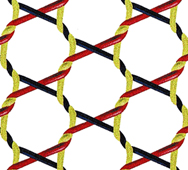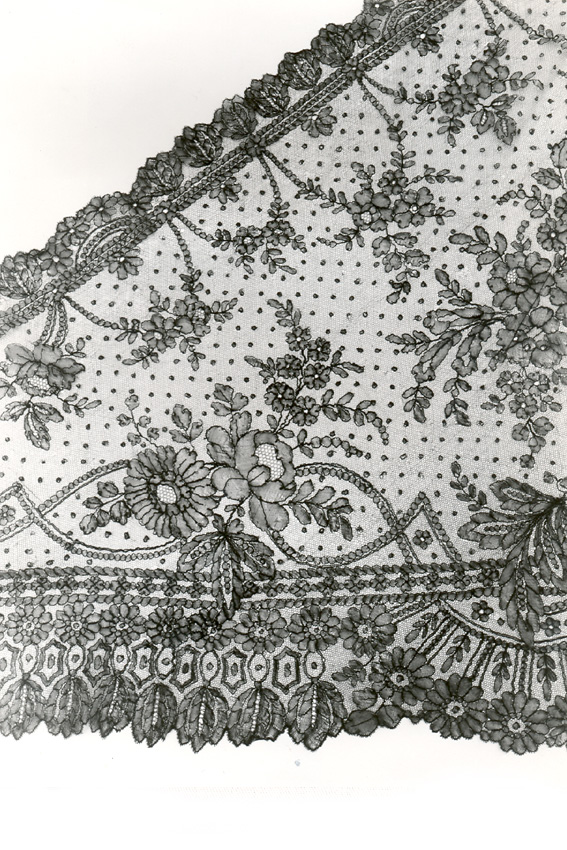|
Pusher Machine
The Pusher machine was a lace making machine, based on the bobbinet, that was invented in 1812 Samuel Clark and James Mart. Context In 1812 Samuel Clark and James Mart(sic) constructed a machine that was capable of working a pattern and net at the same time. A ''pusher'' operated each bobbin and carriage independently, allowing almost unlimited designs and styles. The machine, however, was slow, delicate, costly and could produce only short "webs" of about two by four yards. There is no record of the original specifications, but it origin is referenced in two patent applications made to improve it lodged in 1825, by Joseph Crowder of New Radford and his associates Messrs Hall and Day. Variations on the basic machine were the ''Crowder and Day's improved pusher'' and ''Kendall and Morley's machine''. The machine was modified by John Synyer in 1829. to allow for bullet holes to be inserted in the plain twist net. A modification was made in 1831 to copy blondes, Marmaduke Miller a ... [...More Info...] [...Related Items...] OR: [Wikipedia] [Google] [Baidu] |
Lace Machine
Lace machines took over the commercial manufacture of lace during the nineteenth century. History The stocking frame was a mechanical weft-knitting knitting machine used in the textile industry. It was invented by William Lee of Calverton near Nottingham in 1589. Framework knitting, was the first major stage in the mechanisation of the textile industry at the beginning of the Industrial Revolution. It was adapted to knit cotton, do ribbing and by 1800, with the introduction of dividers (divider bar) as a lace making machine. Bobbinet machines were invented in 1808 by John Heathcoat. He studied the hand movements of a Northamptonshire manual lace maker and reproduced them in the roller-locker machine. The 1809 version of this machine (patent no. 3216) became known as the ''Old Loughborough'', it was wide and was designed for use with cotton. The Old Loughborough became the standard lacemaking machine, particularly the 1820 form known as the Circular producing two-twist plain ... [...More Info...] [...Related Items...] OR: [Wikipedia] [Google] [Baidu] |
Bobbinet
Bobbinet tulle or genuine tulle is a specific type of tulle which has been made in the United Kingdom since the invention of the bobbinet machine. John Heathcoat coined the term "bobbin net", or bobbinet as it is spelled today, to distinguish this machine-made tulle from the handmade " pillow lace", produced using a lace pillow to create bobbin lace. Machines based on his original designs are still in operation today producing fabrics in Perry Street, Chard, Somerset, UK. When bobbinet is woven with spots, it is called point d'esprit. History The forerunner of bobbinet tulle was bobbin lace. Lace has been produced for a long time, made in tedious hand labour with thin thread and needles or bobbins. Bobbin lace is made by weaving the threads by moving the bobbins over or under each other. Much bobbin lace is based on a net ground. By the end of the 18th century, people tried to produce the net ground mechanically. In 1765 they managed to create a tulle-like fabric on a so-cal ... [...More Info...] [...Related Items...] OR: [Wikipedia] [Google] [Baidu] |
Radford, Nottingham
Radford is an inner-city area of Nottingham, located just outside the city centre. The appropriate ward of the City of Nottingham Council is called Radford and Park with a population of 21,414. It is bounded on the south by Lenton and Nottingham City Centre, and comprises around of land. History St Peter's Church, Radford was given by William Peveril to Lenton Priory. The church was rebuilt in 1812 at a cost of £2,000. The Wesleyan chapel was built in 1805 and enlarged in 1828. In September 1878 a chapel was built on St Peter's Street by the United Methodist Free Churches at a cost of £1,900. It was closed owing to declining membership and income in June 1947 and purchased by the Evangelical Free Church. Radford Registration District (RD) was created on 1 July 1837 on the introduction of Statutory Registration of Births, Marriages and Deaths (BMD) - and was abolished, and absorbed into Nottingham RD, on 1 July 1880. Population by year *1811 - 5,704 *1821 - 7,348 *1831 - ... [...More Info...] [...Related Items...] OR: [Wikipedia] [Google] [Baidu] |
William IV Of The United Kingdom
William IV (William Henry; 21 August 1765 – 20 June 1837) was King of the United Kingdom of Great Britain and Ireland and King of Hanover from 26 June 1830 until his death in 1837. The third son of George III, William succeeded his elder brother George IV, becoming the last king and penultimate monarch of Britain's House of Hanover. William served in the Royal Navy in his youth, spending time in North America and the Caribbean, and was later nicknamed the "Sailor King". In 1789, he was created Duke of Clarence and St Andrews. In 1827, he was appointed Britain's first Lord High Admiral since 1709. As his two elder brothers died without leaving legitimate issue, he inherited the throne when he was 64 years old. His reign saw several reforms: the Poor Law was updated, child labour restricted, slavery abolished in nearly all of the British Empire, and the electoral system refashioned by the Reform Acts of 1832. Although William did not engage in politics as m ... [...More Info...] [...Related Items...] OR: [Wikipedia] [Google] [Baidu] |
Shawl
A shawl (from fa, شال ''shāl'',) is a simple item of clothing from Kashmir, loosely worn over the shoulders, upper body and arms, and sometimes also over the head. It is usually a rectangular or square piece of cloth, which is often folded to make a triangle, but can also be triangular in shape. Other shapes include oblong shawls. History The words "shawl" and "pashmina" come from Kashmir, the northern region of the Indian subcontinent. Sources report cashmere crafts were introduced by Sayeed Ali Hamadani who was an Iranian scholar when he came to Kashmir in the 14th century. He found that the Ladakhi Kashmiri goats produced soft wool. He took some of this goat wool and made socks which he gave as a gift to the king of Kashmir, Sultan Qutbuddin. Afterwards, Hamadani suggested to the king that they start a shawl weaving industry in Kashmir using this wool. That is how pashmina shawls began. The United Nations agency UNESCO reported in 2014 that Ali Hamadani was one of the ... [...More Info...] [...Related Items...] OR: [Wikipedia] [Google] [Baidu] |
Chantilly Lace
Chantilly lace is a handmade bobbin lace named after the city of Chantilly,"Chantilly" ''The Oxford English Dictionary''. 2nd ed. 1989. France, in a tradition dating from the 17th century. The famous silk laces were introduced in the 18th century. ''Chantilly lace'', was also produced in the 19th century but this one was actually made not in Chantilly area but in the French Norman town Bayeux and in Geraardsbergen, now in Belgium. Chantilly lace is known for its fine ground, outlined pattern, and abundant detail. The pattern is outlined in ''cordonnet'', a flat untwisted strand. The best Chantilly laces were made of silk, and were generally black, which made them suitable for mourning wear. White Chantilly lace was also made, both in linen and silk, though most Chantilly laces were made of silk. The black silk Chantilly lace became especially popular, and there was a large market for it in Spain and the Americas. Chantilly and the Spanish laces (such as blonde lace) were the ... [...More Info...] [...Related Items...] OR: [Wikipedia] [Google] [Baidu] |
Alençon Lace
Alençon lace (, ) or point d'Alençon () is a needle lace that originated in Alençon, France. It is sometimes called the "Queen of lace." Lace making began in Alençon during the 16th century and the local industry was rapidly expanded during the reign of Louis XIV by Jean-Baptiste Colbert, who established a Royal Workshop in the town to produce lace in the Venetian style in 1665. The purpose of establishing this workshop was to reduce the French court's dependence on expensive foreign imports. Marthe La Perrière had modified the Venetian technique and Alençon emerged as a unique style around 1675 after Colbert's monopoly ended. The lace employs a mesh ground and incorporates pattern motifs with a raised outline of closely packed buttonhole stitches, an outer edge decorated with picots, and open areas with decorative fillings. History Though the demand for lace went into sharp decline following the French Revolution, it recovered some of its popularity during the Second Fre ... [...More Info...] [...Related Items...] OR: [Wikipedia] [Google] [Baidu] |
Lyon
Lyon,, ; Occitan: ''Lion'', hist. ''Lionés'' also spelled in English as Lyons, is the third-largest city and second-largest metropolitan area of France. It is located at the confluence of the rivers Rhône and Saône, to the northwest of the French Alps, southeast of Paris, north of Marseille, southwest of Geneva, northeast of Saint-Étienne. The City of Lyon proper had a population of 522,969 in 2019 within its small municipal territory of , but together with its suburbs and exurbs the Lyon metropolitan area had a population of 2,280,845 that same year, the second most populated in France. Lyon and 58 suburban municipalities have formed since 2015 the Metropolis of Lyon, a directly elected metropolitan authority now in charge of most urban issues, with a population of 1,411,571 in 2019. Lyon is the prefecture of the Auvergne-Rhône-Alpes region and seat of the Departmental Council of Rhône (whose jurisdiction, however, no longer extends over the Metropolis of Lyo ... [...More Info...] [...Related Items...] OR: [Wikipedia] [Google] [Baidu] |






.jpg)